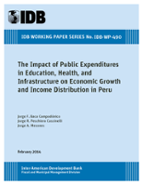The Impact of Public Expenditures in Education, Health, and Infrastructure on Economic Growth and Income Distribution in Peru
Date
Feb 2014
The Peruvian economy has exhibited remarkable growth in the past 20 years. Good tax and monetary policies, along with comprehensive structural adjustment, which has attracted substantial foreign investment, are regarded as the pillars of this success. Notwithstanding the advances experienced on reducing poverty, lowering inequality and unemployment continue to be elusive targets for the Peruvian government and constitute main causes of social unrest. This paper assesses the impact of Peruvian public expenditures in education, health, and infrastructure on economic growth, poverty, and income distribution in the past 20 years using a Dynamic Computable General Equilibrium Model (DCGEM), which is an economy-wide model that describes the behavior of producers and consumers and the linkages among them.




